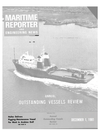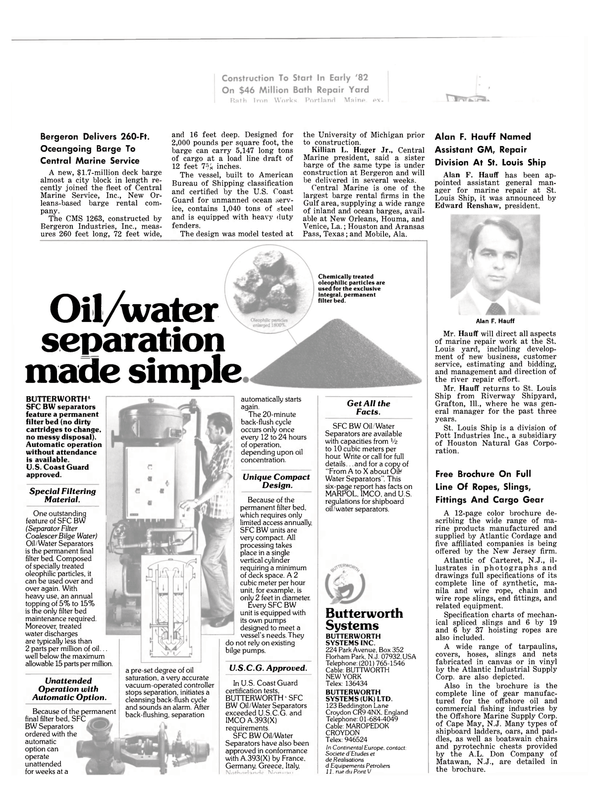
Multipurpose Semisubmersible Built To Handle North Sea Emergencies
The emergency support vessel (ESV) lolair, built by Scott Lithgow Ltd. at Greenock on the Clyde for British Petroleum Ltd.
and the British National Oil Corporation, is undergoing extensive sea trials before final fitting out and service in the North Sea.
Of a semisubmersible construction, the lolair is a new design of an ESV and incorporates the best marine components in a complex design first put onto paper five years ago. Launched in April and now undergoing extensive sea trials, she is designed to provide a fire-fighting — including well-kill — capability as well as the diving, maintenance, construction, and accommodation facilities.
A four-deck platform 76.5 meters by 51.5 meters (about 251 by 169 feet) sits atop six columns connected to identical-twin pontoons.
The $120-million lolair was initially designed as a support vessel in the mid-70s. However, following the Ekofisk blowout in 1977, an emergency role became the prime consideration.
The lolair will be available to attend an emergency outside the North Sea Forties and Thistle fields which it will patrol for the joint owners.
Her operational displacement of 19,600 tons is lighter than any comparable vessel currently in operation.
This, together with a lack of any horizontal bracing between columns or pontoons, gives her a transit speed of 12.5 knots, enough to outstrip any other ESV. Bracing is provided by inverted Vs running f r om column base to mid-platform. Any single bracing member can be lost without affecting capability.
Transit draft will be no more than 6.9 meters.
The 102-meter-long pontoons (about 335 feet) contain fuel, water and ballast compartments, as well as pump and motor rooms.
Each of the two after motor rooms houses two 2.42-mw Laurence Scott 6.6-kv electric motors that drive the propellers and a 1.5-mw motor f o r d r i v i n g a t h r u s t e r . The forward motor rooms house a 1.5-mw thruster motor and a 2.42-mw motor driving a fire pump thi-ough a variable speed fluid coupling.
The six 6.6-kv Laurence Scott generators are powered by six 3.4-mw German-designed M.A.N, diesels built under license in Britain by Harland and Wolff, Belfast.
They are situated in two separate engine rooms on the platform itself and are provided with a switchboard arrangement which, by separating them into three sections, gives a double fall back in an emergency.
At the heart of the Iolair's ability to function in an emergency and support role to rigs and platforms in the North Sea is her dynamic positioning system.
The system, supplied by Kongsberg of Norway, uses three computers to control the main SMM propellers and the four SMM lateral thrusters which are positioned transversly in tunnels in the fore and after ends of each pontoon.
The system, which enables the ESV to hold position continuously in high seas, also can be used in conjunction with four anchors deployed one from each corner of the platform.
The Worthington Simpson xirefighting system incorporates 16 Knowsley monitors. The vessel is capable of pumping 10,200 cubic meters of water an hour onto a blazing rig 180 meters distant continuously for at least 21 days before having to bunker more fuel. During that time the lolair would keep her own area cool by showering her total surface area with 5,500 cubic meters of water per hour.
For a top-kill exercise, bulk mud powder permanently stored in four 40-cubic-meter silos in each corner leg would be mixed onboard with chemicals and then pumped at pressure into the well of a striken rig via a telescopic emergency gangway located at the starboard aft-corner of the vessel.
This gangway also will land or evacuate rig personnel. There is a small ward and fully equipped operating room onboard. Specialized medical personnel will be flown to the ESV when required.
During emergency operations, all n o n e s s e n t i a l crewmen will be lifted off.
When, she turns to her daily work however, the Iolair's task is more mundane. Named after a Gaelic eagle she will take up to 120 transient oilmen under her wing as well as offer a fortnightly home to her crew of 100.
The platform deck accommodates a helicopter hanger and landing pad, the view around bridge, a small workshop and two cranes. Both—one capable of 40- ton and the other capable of 100- ton loads—can be used through a moon pool in the platform structure.
For heavier work, strongpoints beneath the moon pool allow the lolair to lift 500 tons up to three meters off the seabed through her own buoyancy. Her operational draft of 15.25 meters will put the platform 17 meters above sea level while work is taking place.
An integral diving center provides facilities f o r up to 22 divers employed in both surface work (up to 50 meters down) and saturation diving (to 300 meters down).
Living and sleeping compression accommodation f o r up to six divers allows saturation work to be u n d e r t a k e n c o n t i n u o u s ly through a bell lowered down a tube in the center starboard column.
An official christening ceremony for the vessel will take place at handover. As yet no date has been fixed for this.
Read Multipurpose Semisubmersible Built To Handle North Sea Emergencies in Pdf, Flash or Html5 edition of December 1981 Maritime Reporter
Other stories from December 1981 issue
Content
- MarAd Approves Farrell Lines Ship Charter To Military Sealift Command page: 4
- 83 Vessel $3.4-Billion Program Planned By Japanese Shippers page: 4
- Veliotis Takes New Post With General Dynamics page: 4
- Petroterminal De Panama Selects EMH To Construct Tanker-Loading Buoys page: 6
- Name Peter West VP Of Transway Operations page: 6
- Sun Company, Levingston Sign Letter Of Intent For Pa. Shipyard Sale page: 6
- American Steamship Names D. Ward Fuller As Its Chief Operating Officer page: 6
- SNAME-Hampton Roads Hears Paper On Fuel Savings In Cargo Heating Systems page: 10
- Multipurpose Semisubmersible Built To Handle North Sea Emergencies page: 10
- Maher Expands Container Facility, To Install First Paceco Transtainers In N.Y. page: 15
- Kvaerner, Oy Navire To Merge Shipbuilding, Equipment Capabilities page: 15
- Baldt Inc. Develops New Abrasion-Resistant Chain —Brochure Available page: 15
- Kaiser Engineers Awarded Service Contract For Trident Sub Facilities page: 16
- SNAME Philadelphia Section Discusses Ship Design By Personal Computers page: 18
- M/V Europa Completes Sea Trials; Luxury Cruise Liner Filled With Many Environmental Safeguards page: 18
- Gulf Oil Announces Exec Assignments For Corporation And Divisions page: 18
- Award RCA $339 Million In Contracts For Navy's Aegis Weapon Systems page: 19
- Three Top Management Changes At Levingston page: 20
- Outstanding Vessels page: 22
- Largest U.S.-Built Hopper Dredge Launched At Avondale Shipyards page: 22
- ASNE Flagship Section Hears Paper On Engineering Costs And Risks page: 22
- DredgeMasters To Acquire Aquamarine Corporation page: 24
- Advanced Marine To Design New Ferryboat page: 24
- Newfoundland's Ocean Cargo Services Seen Expanding With Coming Offshore Oil Boom page: 24
- Soviets Plan Nuclear Powered Merchant Ship, To Be Completed By 1984 page: 25
- Spanish Shipbuilders Assoc. Publishes New Brochure —Copies Available page: 26
- Name John Malagraph General Manager Of Advanced Marine In N.Y. page: 26
- Shell To Provide Bunkering Service At Port Of Mobile —Literature Available page: 27
- Appoint Hession President Of Koehring Clyde, Whirley Crane Producer page: 27
- Name Parks President Of Farrell Lines page: 27
- Todd-Seattle Sponsors Marine Diesel Seminar page: 28
- Norcontrol To Install $3-Million Vessel Traffic System —Literature Available page: 28
- SNAME page: 36
- Moss Rosenberg Verft Develops Energy-Saving LNG Carrier page: 41
- $2.1-Million Title XI Guarantee For Tanker IGS And COW Retrofit page: 41
- SNAME New York Hears Paper On Marine Gas Chemists page: 42
- Utility Vessel M/V Lamnalco Mallard Delivered To Kuwait Service By HUDSHIP page: 42
- SNAME-New England, ASNE Hear Rear Adm. Beecher On Battleship Reactivation page: 42
- Allis-Chalmers Receives $6-Million M u d Pump Order From Wilson page: 43
- $1 -Billion Lube Oil Refinery To Be Constructed In Saudi Arabia page: 43
- Deliver 13th Supply Boat To Marsea Agencies Fleet, Plan Eight More For 1982 page: 48
- Paducah Marine Ways To Add Fab & Prop Shops page: 48
- Brown & Root Affiliate Awarded Pipeline Contract In Danish North Sea Area page: 50
- Maritime Safety Group Honors 12 Persons For Technical Presentations page: 50
- Award $12-Million Contract To Uniflite For Boats Used By Navy's Special Forces page: 53
- Hold Dedication And Ribbon-Cutting Ceremony At New Bell Halter Yard page: 53
- SNAME's Great Lakes And Rivers Section Meets At Universty Of Michigan page: 56
- Canadian Shipbuilders Group Sets Date For 1982 Conference page: 56
- Sperry Introduces New Ship Control System —Literature Available page: 57
- St. Louis Ship Announces Management Appointments At Engine Repair Division page: 58
- New Brochure Describes Allied Water/SweetWater R/O Water Maker page: 58
- Papers On Containerships, Bulkers Presented By SNAME California Sections page: 60
- Submarine LNG Carrier Proposed By General Dynamics For Arctic Regions page: 60
- Joseph Lykes To Retire As Head Of Lykes Steamship; James Amoss To Be CEO page: 69
- Student Papers Meeting Held By SNAME New England Section page: 69
- Coast Guard Proposes Maneuvering Standards For U.S.-Flag Vessels page: 70
- MSC Accepts Third Sea-Land Containership page: 70
- Commission Destroyer USS Scott Third Ship In A New Class page: 81
- Nuclear Attack Submarine La Jolla Commissioned At New London page: 81
- Bergeron Delivers 160-Foot Tank Barge Tide Mar 34 To Tidewater Marine page: 87
- Kings Craft Delivers Matmar Drill III, Third Of Four Crewboats From Yard page: 87


